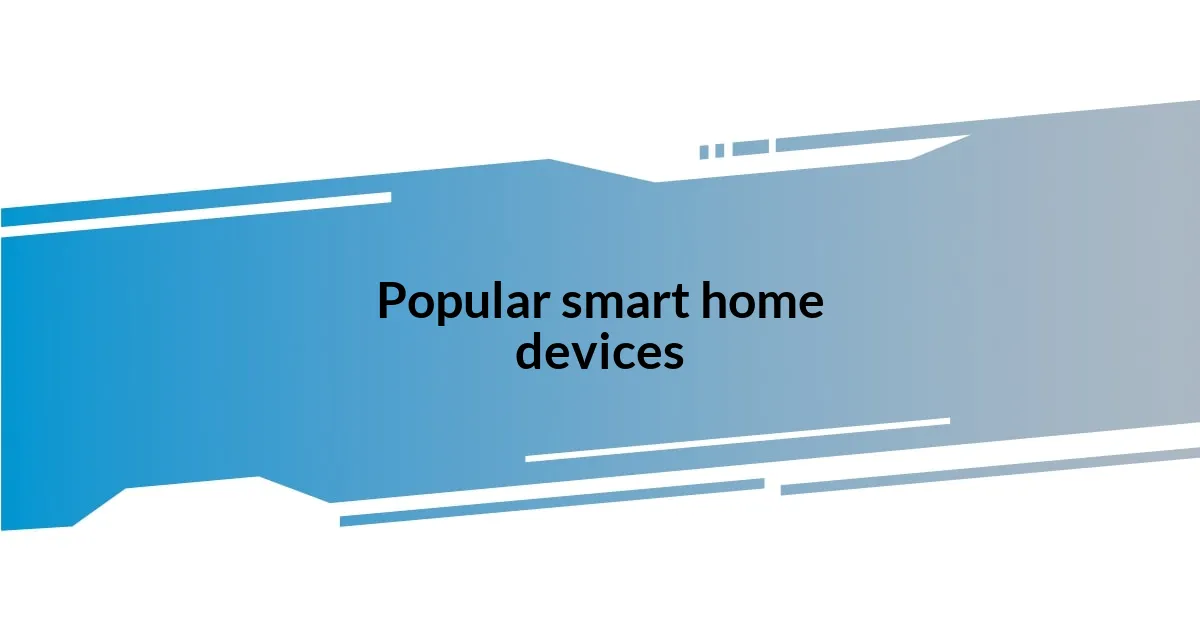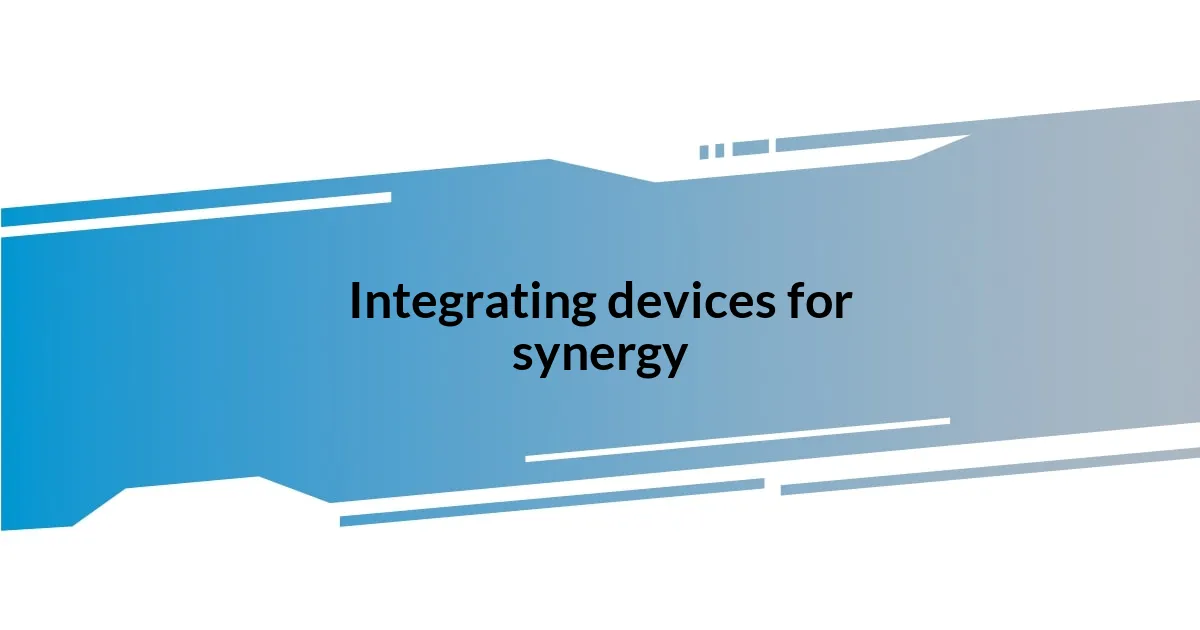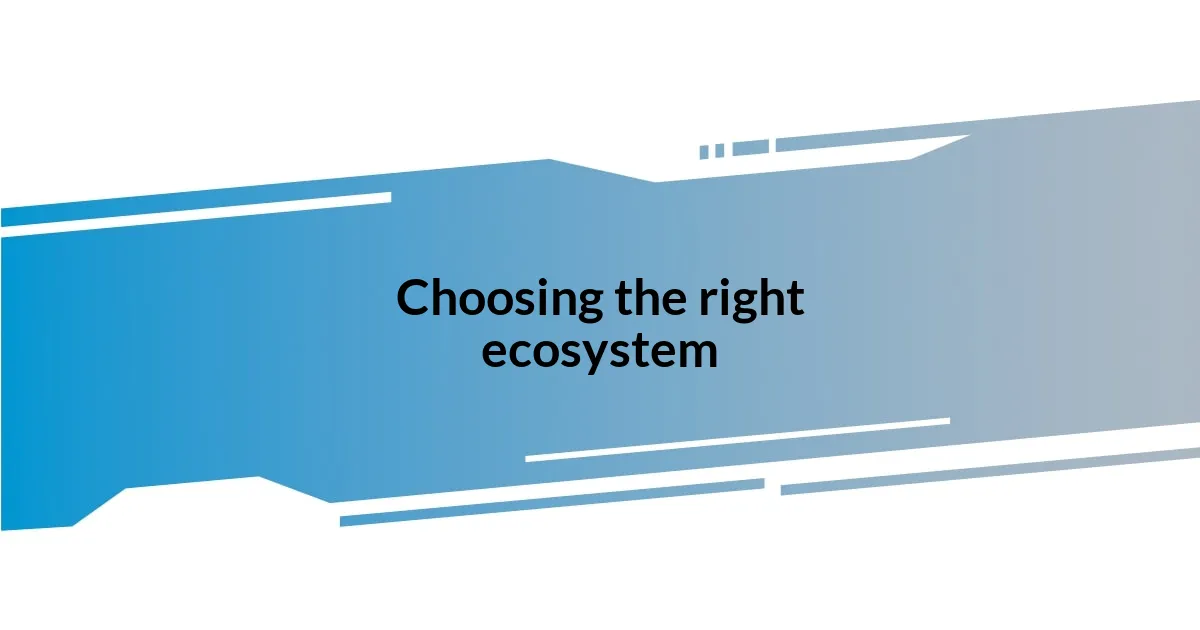Key takeaways:
- Smart home ecosystems enhance daily life by integrating devices for comfort, convenience, and security.
- Key benefits include automation of tasks, energy efficiency, remote management, and customization.
- Privacy and security concerns arise from data collection and potential vulnerabilities in interconnected devices.
- Future trends indicate a focus on AI advancements, sustainability, and improved interoperability among devices.

Understanding smart home ecosystems
Smart home ecosystems are essentially networks of devices that communicate with each other to enhance home automation and improve our daily lives. I still remember the first time I stepped into my living room and saw my smart bulb automatically dim to a cozy setting as my favorite playlist started, all thanks to my voice command. Doesn’t it feel magical when technology anticipates your needs?
These systems can include anything from smart speakers and thermostats to security cameras and smart locks, creating a cohesive environment. I often find myself wondering how I ever managed without them—navigating manual switches and separate apps feels so outdated now. The ability to control multiple devices from one hub not only simplifies my life but also adds a layer of comfort and security that I truly treasure.
One key component of a smart ecosystem is the ease of management through centralized platforms, like Google Assistant or Amazon Alexa. It’s incredible how my voice can command my entire home, but it does raise a thought—what happens if these systems go down? My experience shows that while they offer convenience, ensuring a reliable connection and backup options can save us from frustration. The balance between innovation and our everyday reliance on it is a pivotal aspect of understanding smart home ecosystems.

Benefits of smart home systems
One of the most significant benefits of smart home systems is the convenience they bring to our daily routines. I vividly recall the late nights when I’d come home, exhausted after a long day, only to realize I could unlock my door and turn on the lights with a simple voice command. It felt like I had a personal assistant at my service, ready to enhance my comfort without me lifting a finger. That seamless integration truly reshaped how I experience my home.
Additionally, smart home systems offer substantial energy savings and heightened security. By automating heating and cooling based on my schedule, I often see lower utility bills. The peace of mind that comes with real-time security alerts or the ability to monitor my home from anywhere is invaluable. Here’s a quick summary of the benefits:
- Convenience: Automation of daily tasks saves time and effort.
- Energy efficiency: Smart devices optimize energy usage, reducing costs.
- Enhanced security: Real-time monitoring provides greater peace of mind.
- Remote control: Manage everything from your smartphone, wherever you are.
- Customization: Tailor settings to fit your lifestyle and preferences.

Popular smart home devices
Smart home devices are all about making life smoother and more enjoyable. For instance, I can’t get enough of my smart thermostat; it learns my routine and adjusts the temperature accordingly. Walking into a perfectly warmed home after a chilly day feels like a warm hug, doesn’t it? It’s amazing how technology can adapt to our habits, bringing a personal touch to comfort.
Similarly, smart speakers have completely changed how I enjoy my evenings. I remember hosting friends for movie night, and with just a simple voice command, the lights dimmed, the popcorn popped, and the music flowed seamlessly. Those moments create such delightful memories, turning ordinary gatherings into extraordinary experiences. Plus, being able to ask my speaker to play trivia games during downtime adds a fun twist that keeps everyone entertained.
Security devices, like smart locks and cameras, have provided me with an unexpected sense of freedom. I still recall a night when I accidentally left the front door unlocked; I was able to check my camera feed from my phone, locking it remotely without a second thought. It’s that reassurance on a busy day, knowing I can keep tabs on my home despite being miles away, that really captures the essence of smart home devices.
| Device | Functionality |
|---|---|
| Smart Thermostat | Automatically adjusts temperature for comfort and energy savings |
| Smart Speaker | Voice-controlled speaker that plays music, controls devices, and answers questions |
| Smart Lock | Keyless entry system that can be controlled remotely |
| Smart Camera | Real-time security monitoring accessible via smartphone |

Integrating devices for synergy
Integrating devices in a smart home ecosystem creates a harmonious environment that enhances our daily lives. I remember the first time I set my smart lights to sync with my smart speaker’s music. The atmosphere transformed instantly; it was like I had a mini nightclub right in my living room. Have you ever experienced that exhilarating shift when technology caters to your specific mood?
The synergy between devices begins with seamless communication. For instance, when my smart thermostat pre-heats the house while I’m still on my way home, it feels like my own digital concierge is keeping me in mind. It’s incredible how these devices can share information, working together to tailor my home to my preferences. Imagine walking into a space that feels perfectly curated just for you.
Moreover, the integration of security devices into this ecosystem adds another layer of peace. I recently set up my smart camera to send alerts about any unusual movement, and I felt a wave of comfort wash over me. Have you ever worried about leaving your home unattended? With my devices working in tandem—locking the door as I leave and monitoring for intruders—it’s as if I’m never really away. Such integration not only safeguards my space but also enriches my living experience, creating a smart home that truly understands me.

Choosing the right ecosystem
Choosing the right smart home ecosystem can feel overwhelming with so many options available. I remember the moment I had to decide between Google Home and Amazon Alexa; it wasn’t just about the devices but also about how they fit into my lifestyle. Considering compatibility with the devices I already owned helped clarify my choice. Have you ever found yourself entangled in features you might never use?
It’s essential to think about what matters most to you. For instance, my friend prioritized security systems and chose an ecosystem that seamlessly integrated smart locks and cameras. When she installed it, I saw an immediate change in her peace of mind. Just imagine knowing your home is protected while getting updates on your phone. Doesn’t that sound like the perfect combination of safety and convenience?
I also learned that different ecosystems offer various levels of customization and control. Personally, I’ve enjoyed the flexibility of my ecosystem, allowing me to automate routines—like having my coffee maker brew a cup as I wake up. I think about how these little conveniences transform my mornings. What features would make your life easier? By reflecting on your daily habits, you can find an ecosystem that not only fits but enhances your lifestyle.

Privacy and security concerns
Just like everyone, I have my concerns about privacy and security with smart home ecosystems. When I first set up my devices, I was pleasantly surprised at how convenient they were—until I read about potential vulnerabilities. It struck me when I learned that smart speakers might be listening even when you think they aren’t. Have you ever thought about what that means for your conversations at home? That realization left me feeling a bit uneasy.
Another aspect that gives me pause is the sheer amount of data these devices collect. It’s amazing how they can learn our habits and preferences, but I can’t help but worry about where that data goes. I remember discussing this with a friend whose smart thermostat seemed to know when she was home and when she wasn’t. She loved the energy savings, but we both wondered: who else has access to that information? The thought of someone else having a sneak peek into my routine is unsettling.
Then there’s the issue of device integration and potential hacking. I once read about a neighbor whose smart doorbell was compromised, allowing someone to break in without setting off alarms. It certainly made me rethink how interconnected my devices should be. Can you imagine the chaos if a hacker could control your locks or security cameras? For me, balancing convenience with security feels like walking a tightrope. It’s critical to stay informed and regularly update my devices, taking those extra steps to protect my home and privacy.

Future trends in smart homes
As I look to the future of smart homes, I’m especially excited about the rise of artificial intelligence. Imagine your devices learning your daily routines so well that they anticipate your needs before you even think of them. I can vividly recall a time when I wished my smart speaker could remind me to water my plants, and now that seems so achievable with the advancements in AI technology. Isn’t it fascinating how these systems could evolve to be more than just tools but genuine household companions?
Another trend I can’t help but notice is the increasing emphasis on sustainability. With the climate crisis so urgent, many smart home ecosystems are integrating energy-efficient features that help save both resources and money. I recently switched my bulbs to smart ones that adjust based on natural light, which not only brightened my home but also lowered my electricity bill. Have you ever thought about how small changes like this could contribute to a larger environmental impact? It gives me hope that technology can actively participate in creating a greener future.
I also foresee a shift towards even greater interoperability between devices from different brands. Gone will be the days when I worried whether my smart fridge could communicate with my coffee maker. I remember feeling frustrated when I bought a new smart gadget but found out it wouldn’t work with my existing devices. The thought of a future where all systems come together seamlessly gives me a sense of relief and excitement. Wouldn’t it be nice if we could easily control everything from one central point? That kind of convenience could truly revolutionize our daily lives.